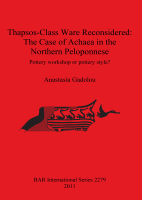Description
BOOK DESCRIPTIONRecent excavations in the region of Achaea in the northern Peloponnese (Greece) have brought to light new evidence on the Thapsos-class of vases. Their identification amongst the grave goods as well as the dedications in the two important sanctuary sites of the area provide a starting point for reassessing the question of this particular ware's identity and its main production centre. After a brief introduction on the aims and scope of the study, the history of the research, the distribution of Thapsos-class ware in Achaea, its technical features and a short discussion on chronological issues, the various fabrics of the Thapsos-class ware attested in Achaea are first presented and analyzed, and then examined and discussed with particular respect to their resemblance with the Achaean Late Geometric workshops producing the impressed and fine painted wares. Next the similarities, as well as the differences, of vases of this class recovered mainly from Ithaca, Delphi and Thera but also from other areas of mainland Greece are set out. A full catalogue of the Thapsos class ware data derived so far from Achaea is submitted with photographs and drawings of almost every sherd and vase. Finally the results of a non destructive elemental ceramic analysis using micro X-RAY fluorescence spectroscopy (m-XRF) applied to various fabrics and wares from Achaean pottery of the Late Geometric period is published in the Appendix. A more fundamental aim of the present study is to bring forward new aspects for investigation concerning this ceramic group, so closely associated as it is with the foundation and life of the Greek colonies in the west. Non destructive elemental ceramic analysis from Achaea using X-Ray fluorescence spectroscopy (m-XRF)











